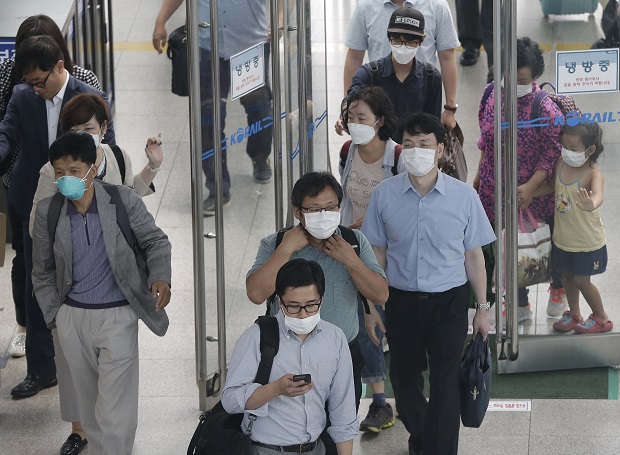
People wear masks as a precaution against MERS (Middle East Respiratory Syndrome) as they arrive at Seoul Railway Station in Seoul, South Korea, Tuesday, June 16, 2015. The death toll continued to mount in South Korea’s MERS outbreak on Tuesday even as schools reopen and people recover from the virus. AP
SEOUL, South Korea – South Korea announced its 20th death from the MERS virus Wednesday as criticism grew over authorities’ ability to contain the outbreak, with alarming reports of new cases slipping through a quarantine that already affects thousands.
A 54-year-old woman died of Middle East Respiratory Syndrome Wednesday morning, about two weeks after being diagnosed on June 5, the health ministry said.
It also reported eight new patients — including four who had been infected in Samsung Medical Centre in Seoul, considered the epicentre of the outbreak — a day after the ministry said it was cautiously optimistic that the worst was over as the number of new cases appeared to be falling.
Almost all infections so far have been limited within hospitals.
But several new patients diagnosed in recent days were not among those placed under quarantine.
One patient reported Tuesday in the southeastern city of Daegu had developed symptoms on Saturday — but continued normal daily activities, including going to work and taking a trip to a public bathhouse.
The 52-year-old public servant, currently in isolation, visited his mother in late May while she was a patient in the Samsung hospital, and his sister was diagnosed with MERS on June 10, the Daegu city council said Wednesday.
Another patient — a 55-year-old ambulance driver at the Samsung hospital — also continued to go to work via subway for days after developing symptoms including fever on June 2. He was officially diagnosed last Friday, the health ministry said.
Dong-A Ilbo, Seoul’s major conservative newspaper, slammed the government for “unrealistically” playing down the magnitude of the outbreak.
“All the optimistic words and predictions from health authorities have turned out to be wrong so far,” it said in an editorial on Wednesday.
“We are concerned whether (health minister) Moon Hyung-Pyo … will ever be able to keep the situation under control,” it said.
– Hospital at epicentre –
A staff member at Samsung hospital is also among the eight new cases announced Wednesday, though the health ministry said it was unclear where the 33-year-old had been infected.
About 80 patients, visitors and workers have contracted the virus in the hospital — one of the country’s largest, which suspended most operations on Sunday to stem the further spread of the disease.
Staff members at two other hospitals were also diagnosed, as well as a patient in the city of Hwaseong, about 43 kilometers (26.7 miles) south of Seoul.
The number of people who were exposed to patients and placed under quarantine — either at state facilities or at home — jumped by 922 to more than 6,500 people, the ministry said Wednesday.
A total of 19 people have recovered and were released from hospital, it added.
The virus appeared in South Korea on May 20 when a 68-year-old man was diagnosed after returning from a trip to Saudi Arabia.
Since then it has spread at an unusually rapid pace, sparking widespread public alarm over what has become the largest outbreak outside Saudi Arabia.
On Tuesday, the health ministry said the number of new cases had gradually declining from 12 on Friday to four that day, sparking hope the outbreak might be showing signs of easing.
There is no vaccine for MERS which has a mortality rate of 35 percent, according to the WHO.
In Saudi Arabia, more than 950 people have been infected and 412 died of the virus.